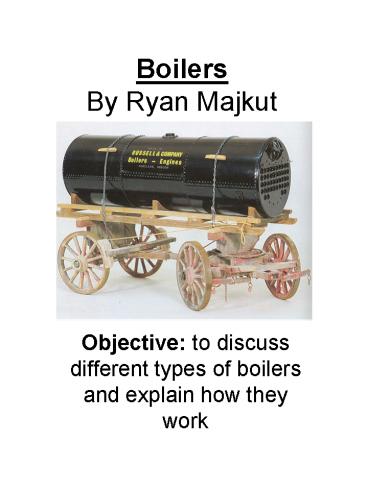Boilers By Ryan Majkut - PowerPoint PPT Presentation
1 / 9
Title: Boilers By Ryan Majkut
1
BoilersBy Ryan Majkut
- Objective to discuss different types of boilers
and explain how they work
2
What is a Boiler?
- A water containing vessel which transfers heat
from a fuel source (oil, gas, coal) into steam - This steam is piped to a point where it can be
used to run production equipment, to sterilize,
provide heat, to steam-clean, etc - Boilers are commonly used to heat larger office
buildings - They work by sending hot water through pipes
around the building that heat up the air around
them and cause the room to get warmer
3
Fire-tube Boiler
- A fire-tube boiler was more common in the 1800s.
It consists of a tank of water perforated with
pipes. The hot gases from a coal or wood fire run
through the pipes to heat the water in the tank,
as shown here - The whole tank is under pressure, so if the tank
bursts it creates a major explosion
4
Water-tube Boiler
- More common today are water-tube boilers, in
which water runs through a rack of tubes that are
positioned in the hot gases from the fire
5
Boiler Systems
- Closed System- The energy given up by the steam
is sufficient to convert it back into the form of
water. When 100 of the steam produced is
returned to be reused, the system is called a
closed system. - Open System- Since some processes can contaminate
the steam, it is not always desirable to feed the
condensate back into the boiler. A system that
does not return the condensate is called an open
system. - A More Complex Water-tube Boiler
6
Condensing Boiler
- uses a secondary heat exchanger or condensing
coil to recover heat from the hot flue gases - The temperature of this flue gas will be near to
that of flame.
7
Feed Water Contamination
- The boiler receives the feed water, which
consists of recovered condensed water (return
water) and fresh water (make-up water) - The steam, which escapes from the boiler,
frequently contains liquid droplets and gases - The water remaining in liquid form at the bottom
of the boiler picks up all the foreign matter
from the water that was converted to steam - These impurities lead to poor heat transfer and
reduction in the efficiency of the boiler - The impurities must be blown down by the
discharge of some of the water from the boiler to
the drains
8
More Complex Systems
- Boilers may contain additional components such
as - Economizers to increase the boiler efficiency
- Superheaters to heat the steam above the
saturation temperature - Process heaters and steam turbine systems to
power a variety of steam - Feedwater heaters to remove dissolved gases, such
as oxygen
9
References
- http//www.alken-murray.com/Boilerworks.html
- home.btconnect.com/.../ condensing_boiler.htm
- http//www.business-wiz.com/products/boilers.html
- http//www.abma.com/pack_ft_boilers.php
- www.lenntech.com/boiler/ boiler-feed-water.htm































